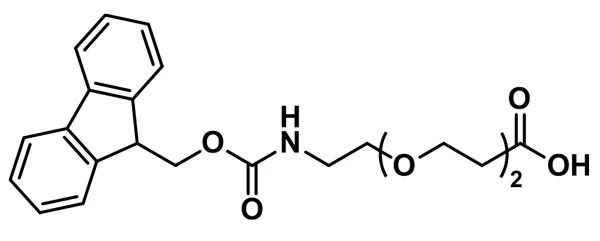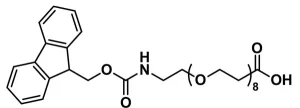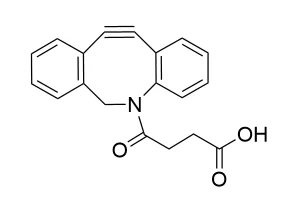Description
Fmoc-N-amido-dPEG®2-acid, product number QBD-10243, is a peptide synthesis product used to introduce a short (10 atoms), hydrophilic spacer into a peptide chain using standard peptide chemistry. The Fmoc protecting group can be removed using standard peptide chemistry.
Fmoc-N-amido-dPEG®2-acid, QBD-10243, works well in solid-phase and solution-phase synthetic processes. The dPEG® can be joined to the N-terminal end of a peptide chain. After removal of the Fmoc protecting group, further synthesis can be carried out to create a peptide with a flexible hinge. The peptide sequences on either side of the dPEG® spacer can be identical or different.
In addition, the short dPEG® linker can provide spacing between two units in a synthetic construct where steric hindrance is a problem. The amphiphilic nature of dPEG® means that the construct will gain water solubility while remaining soluble in an organic solvent. The Fmoc protecting group removes easily with a solution of piperidine in N,N-dimethylformamide (DMF).
References
Greg T. Hermanson, Bioconjugate Techniques, 3rd Edition, Elsevier, Waltham, MA 02451, 2013, ISBN 978-0-12-382239-0; See Chapter 18, Discrete PEG Reagents, pp. 787-821, for a full overview of the dPEG® products.
Functional PEG-Modified Thin Films for Biological Detection. Aaron S. Anderson, Andrew M. Dattelbaum, Gabriel A. Montano, Dominique N. Price, Jurgen G. Schmidt, Jennifer S. Martinez, W. Kevin Grace, Karen M. Grace, and Basil I. Swanson. Langmuir. 2008, 24 (5), pp 2240–2247. January 30, 2008. DOI: 10.1021/la7033438.
Polyproline-Rod Approach to Isolating Protein Targets of Bioactive Small Molecules: Isolation of a New Target of Indomethacin. Shin-ichi Sato, Youngjoo Kwon, Shinji Kamisuki, Neeta Srivastava, Quian Mao, Yoshinori Kawazoe, and Motonari Uesugi. J. Am. Chem. Soc. 2007, 129 (4), pp 873–880. January 4, 2007. DOI: 10.1021/ja0655643.
Oriented Surface Immobilization of Antibodies at the Conserved Nucleotide Binding Site for Enhanced Antigen Detection. Nathan J Alves, Tanyel Kiziltepe, and Basar Bilgicer. Langmuir. 2012, 28 (25) pp 9640-9648. May 21, 2012. DOI: 10.1021/la301887s.
Enhanced Cellular Uptake of Peptide-Targeted Nanoparticles through Increased Peptide Hydrophilicity and Optimized Ethylene Glycol Peptide-Linker Length. Jared F. Stefanick, Jonathan D. Ashley, and Basar Bilgicer. ACS Nano. 2013, 7 (9) pp 8115–8127. August 29, 2013. DOI: 10.1021/nn4033954.
Selective photocrosslinking of functional ligands to antibodies via the conserved nucleotide binding site. Nathan J. Alves, Matthew M. Champion, Jared F. Stefanick, Michael W. Handlogten, Demetri T. Moustakas, Yunhua Shi, Bryan F. Shawd, Rudolph M. Navari, Tanyel Kiziltepe, Basar Bilgicer. Biomaterials. 2013, 34 (22) pp 5700–5710. April 16, 2013. DOI:.org/10.1016/j.biomaterials.2013.03.082.
Design, Synthesis and Evaluation of a Neurokinin 1 Receptor-Targeted Near IR Dye for Fluorescence Guided Surgery of Neuroendocrine Cancers. Ananda Kumar Kanduluru, Madduri Srinivasarao, and Philip S. Low. Bioconjugate Chemistry. 2016, pp 1-20. August 16, 2016. DOI: 10.1021/acs.bioconjchem.6b00374.
One-Pot Isolation of a Desired Human Genome Fragment by Using a Biotinylated pcPNA/S1 Nuclease Combination. Arivazhagan Rajendran , Narumi Shigi, Jun Sumaoka, and Makoto Komiyama. Biochemistry. 2018, 57, pp 2908-2912. May 3, 2018. DOI: 10.1021/acs.biochem.8b00202.
Stapled, Long-Acting Glucagon-like Peptide 2 Analog with Efficacy in Dextran Sodium Sulfate Induced Mouse Colitis Models. Peng-Yu Yang , Huafei Zou, Candy Lee, Avinash Muppidi, Elizabeth Chao, Qiangwei Fu, Xiaozhou Luo, Danling Wang, Peter G. Schultz, and Weijun Shen. Journal of Medicinial Chemistry. 2018, 61, pp 3218-3223. March 12, 2018. DOI: 10.1021/acs.jmedchem.7b00768.
Evaluation of the Pharmacokinetic Effects of Various Linking Group Using the 111In-DOTA-X-BBN(7−14)NH2 Structural Paradigm in a Prostate Cancer Model. Jered C. Garrison, Tammy L. Rold, Gary L. Sieckman, Farah Naz, Samantha V. Sublett, Said Daibes Figueroa, Wynn A. Volkert and Timothy J. Hoffman. Bioconjugate Chem. 2008, 19 (9) pp 1803–1812. August 20, 2008. DOI: 10.1021/bc8001375.
PEG-Peptide Conjugates. Ian W Hamley. Biomacromolecules. 2014. April 1, 2014. DOI: 10.1021/bm500246w.
Dual-receptor targeted strategy in nanoparticle design achieves tumor cell selectivity through cooperativity. Jared Francis Stefanick, David Thomas Omstead, Tanyel Kiziltepeabc and Basar Bilgicer. Nanoscale. 2019. Fenruary 17, 2019. DOI: 10.1039/C8NR09431D
Designer covalent heterobivalent inhibitors prevent IgE-dependent responses to peanut allergen. Peter E. Deak, Baksun Kim, Amina Abdul Qayum, Jaeho Shin, Girish Vitalpur, Kirsten M. Kloepfer, Matthew J. Turner, Neal Smith, Wayne G. Shreffler, Tanyel Kiziltepe, Mark H. Kaplan, and Basar Bilgicer. 2019. April 8, 2019. DOI: 10.1073/pnas.1820417116
Membrane-Fusogen Distance Is Critical for Efficient Coiled-Coil-Peptide-Mediated Liposome Fusion. Geert A. Daudey, Harshal R. Zope, Jens Voskuhl, Alexander Kros , and Aimee L. Boyle. Langmuir. 2017, 33 (43) pp 12443-12452. 10/5/2017. DOI: 10.1021/acs.langmuir.7b02931.
Design and Evaluation of Novel Polymyxin Fluorescent Probes. Bo Yun , Kade D. Roberts, Philip E. Thompson, Roger L. Nation, Tony Velkov, and Jian Li. Sensors. 2017, 17 (11) pp 2598. 11/11/2017. DOI: 10.3390/s17112598.
Engineering peptide-targeted liposomal nanoparticles optimized for improved selectivity for HER2-positive breast cancer cells to achieve enhanced in vivo efficacy. Baksun Kim, Jaeho Shin, Junmin Wu, David T. Omstead, Tanyel Kiziltepe, Laurie E. Littlepage, Basar Bilgicer. Journal of Controlled Release. 2020. Volume 322, 10 June 2020, Pages 530-541. April 8, 2020. DOI: 10.1016/j.jconrel.2020.04.010
In vivo evaluation of CD38 and CD138 as targets for nanoparticle-based drug delivery in multiple myeloma. David T. Omstead, Franklin Mejia, Jenna Sjoerdsma, Baksun Kim, Jaeho Shin, Sabrina Khan, Junmin Wu, Tanyel Kiziltepe, Laurie E. Littlepage & Basar Bilgicer. Journal of Hematology & Oncology. 2020. 13, Article number: 145 (2020). 11/02/20. DOI: 10.1186/s13045-020-00965-4






